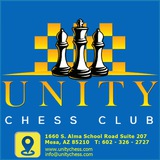29...fxe5 30.Qxg5 e4 31.f6 g6 32.f4 hxg4 33.Be2 gxh3 34.Bh5 Rb2 35.Nh4 Qxf4 36.Qxf4 Bxf4
Unity Chess Club
Paul Keres Vasily Smyslov Bled/Zagreb/Belgrade 1959 Black to move
There is a lack of coordination among the white pieces. Exploiting this, Black creates an object of attack on the queenside:
He should not allow Black to open lines for his rooks; instead, he should prefer 20.bxa5 bxa5 21.Nd4, with chances of equalising.
The pawn stands slightly more actively, taking c4 from the white knight, and opening a path to b6 for the bishop.
24.Nc2 Ra2 25.Nb3 Rc8 26.Ncd4 Bd8! 27.Rxc8 Bxc8 28.Rc1 Bd7 29.Kh1 Qa8 30.Bh4 Bb6 31.Qd1 31...Qa4 32.Be1 h6
33...e5! 34.fxe5 Ng4 35.Be1 dxe5 36.Nf5 Bxf5 37.exf5 Rxg2 38.Rc8+ Kh7 39.d4 Rxh2+ 40.Kg1 Bxd4+
Unity Chess Club
Jacek Gdanski 2395 Boris Gelfand 2585 Adelaide Wch 1988 Black to move
The knight jump into d3 is natural and strong – Black gets the two bishops and active piece play. But in view of the fact that White will have to part with his light-squared bishop, Black first provokes a weakness:
If 17.bxc5 Bxa1 18.cxd6 Qxd6 19.Nxb7 Qe7 20.Nc5 Rb8 21.Nb3 Qf6 22.Kf2 Bc3 23.Qc2 0-0, White does not get full compensation for the exchange.
